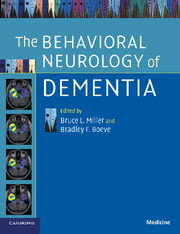Book contents
- Frontmatter
- Contents
- List of contributors
- Section 1 Introduction
- 1 Basic clinical approaches to diagnosis
- 2 Dementia with Lewy bodies
- 3 Neurogenetics of dementia
- 4 Frontotemporal dementia
- 5 Alzheimer's disease
- 6 Mental status examination
- 7 Neuropsychiatric features of dementia
- 8 Neuroimaging in dementia
- 9 Epidemiology and risk factors
- 10 Animal models of dementia
- 11 Neuropathology of dementia
- Section 2 Cognitive impairment, not demented
- Section 3 Slowly progressive dementias
- Section 4 Rapidly progressive dementias
- Index
- References
4 - Frontotemporal dementia
Published online by Cambridge University Press: 31 July 2009
- Frontmatter
- Contents
- List of contributors
- Section 1 Introduction
- 1 Basic clinical approaches to diagnosis
- 2 Dementia with Lewy bodies
- 3 Neurogenetics of dementia
- 4 Frontotemporal dementia
- 5 Alzheimer's disease
- 6 Mental status examination
- 7 Neuropsychiatric features of dementia
- 8 Neuroimaging in dementia
- 9 Epidemiology and risk factors
- 10 Animal models of dementia
- 11 Neuropathology of dementia
- Section 2 Cognitive impairment, not demented
- Section 3 Slowly progressive dementias
- Section 4 Rapidly progressive dementias
- Index
- References
Summary
Introduction
With “baby boomers” now reaching late middle age, degenerative diseases are becoming an increasingly important national health issue. One such disorder, frontotemporal lobar degeneration (FTLD), is particularly devastating to patients and their families, as symptoms include changes in behavior and the erosion of personal relationships, often during the earliest stages. These disease features place great demands on caregivers and the society at large. Understanding the disease and its complexities, and educating the general public with respect to the course and causes of FTLD, is, therefore, acutely important.
The condition typically presents in patients who are between 45 and 65 years of age, and is at least as likely as early-onset Alzheimer's disease (AD) with a prevalence of approximately 15 per 100,000 population etween 45 and 64 years of age. Knopman and colleagues have shown that FTLD is more common than AD in patients under the age of 60 years, while other authors suggest that FTLD-spectrum disorders account for up to 20% of all patients with degenerative dementias. Genetics remain the only known etiology for FTLD, accounting for up to 40% of all cases, although large epidemiology studies investigating other risk factors have yet to be undertaken.
Frontotemporal lobar degeneration encapsulates a heterogeneous group of clinical and pathological syndromes and can begin with behavioral, cognitive, language or motor signs and symptoms.
- Type
- Chapter
- Information
- The Behavioral Neurology of Dementia , pp. 45 - 55Publisher: Cambridge University PressPrint publication year: 2009

